In a market that’s already jam-packed with the best speakers and retro-inspired audio gadgetry, the JBL Authentics 300 manages to stand out from the crowd. It’s a bold move from the brand that many associate with affordable mid-budget tech, and it’s clear from the look of the Authentics range that JBL has the likes of Marshall in its crosshairs. But does the Authentics 300 have the sound (and the smarts) we expect from the best of today’s home audio tech?
Behind that chunky speaker grill and faux leather cabinetry lies a thoroughly modern piece of kit. It’s also the first JBL product to integrate both Amazon Alexa and Google Assistant for home automation and control. It also has integrations for Spotify Connect and Airplay 2. It’s also one of the few wireless speakers in its class to pack some serious power, with a Class D 100w amplifier and a beefy five-and-a-quarter-inch woofer to go with a pair of 1-inch tweeters. Sounds great on paper – but how about in practice?
Resident audio expert Chris Duffill has put his Sonos One and Marshall Stanmore III aside to make way for this chunky chip off the retro audio block. Its looks are based on the company’s legendary L100 speakers that debuted back in 1970. But, design heritage aside, is the Authentics 300 up to the high-end smart speaker standard it aspires to? Or is it just an underwhelming throwback to speakers from the decade that gave us bell-bottom jeans and the mullet haircut? Let’s find out.
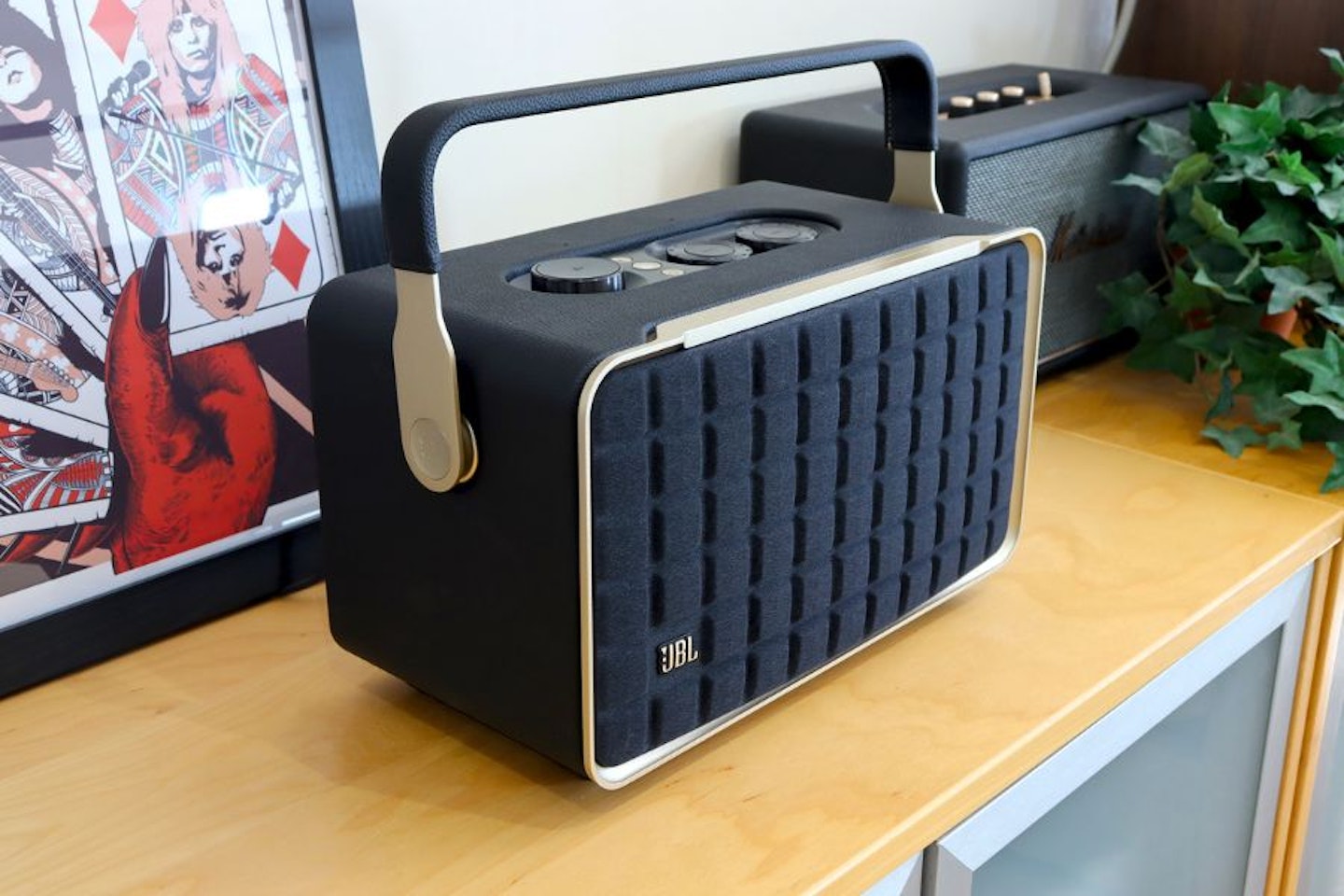
The Quick Version
The JBL Authentics 300 impresses with its robust design and vintage aesthetic. Despite weighing a hefty 4.9kg, it offers modern connectivity features like dual-band Wi-Fi, Bluetooth 5.3, and compatibility with the JBL One app for easy setup and seamless integration with Alexa for multi-room music.
Its sound quality is commendable, powered by dual tweeters, a sizable woofer, and a passive radiator that delivers powerful bass; though it can become overpowering at maximum volumes. The speaker excels in handling a variety of music genres, offering rich and balanced audio, especially when the midrange and bass are boosted using the app's EQ controls
It lacks weather resistance, making it less ideal as a speaker for outdoor use, but its portability within the home is a plus. The controls are straightforward, with intuitive app-based adjustments for finer sound tuning. Though its bass and treble controls could be more tactile, the overall build quality is premium, featuring metal trims and a solid grill. The JBL Authentics 300 is a stylish high-quality speaker for the home and comes highly recommended for its robust performance and excellent smart speaker functionality.
All prices are correct at the time of writing. Prices, stock and deals are subject to change without notice.
Pros
- Well-rounded sound profile with lots of bass
- Alexa and Google Assistant voice control integration
- Authentic retro-inspired design
Cons
- Limited portability due to weight, size and lack of weatherproofing
| Drivers | 1x 5.25-inch woofer, 2x 1-inch tweeters (plus passive radiator) |
| Audio power | 100W |
| Connectivity | Wi-Fi, Bluetooth, Aux-in, USB (for servicing only on UK models) |
| Battery life | 8 hours |
| Charging time | 3 hours |
| Waterproofing | None |
| Dimensions | 22.7 x 38.4 x 22cm (HxWxD) |
| Weight | 4.8kg |
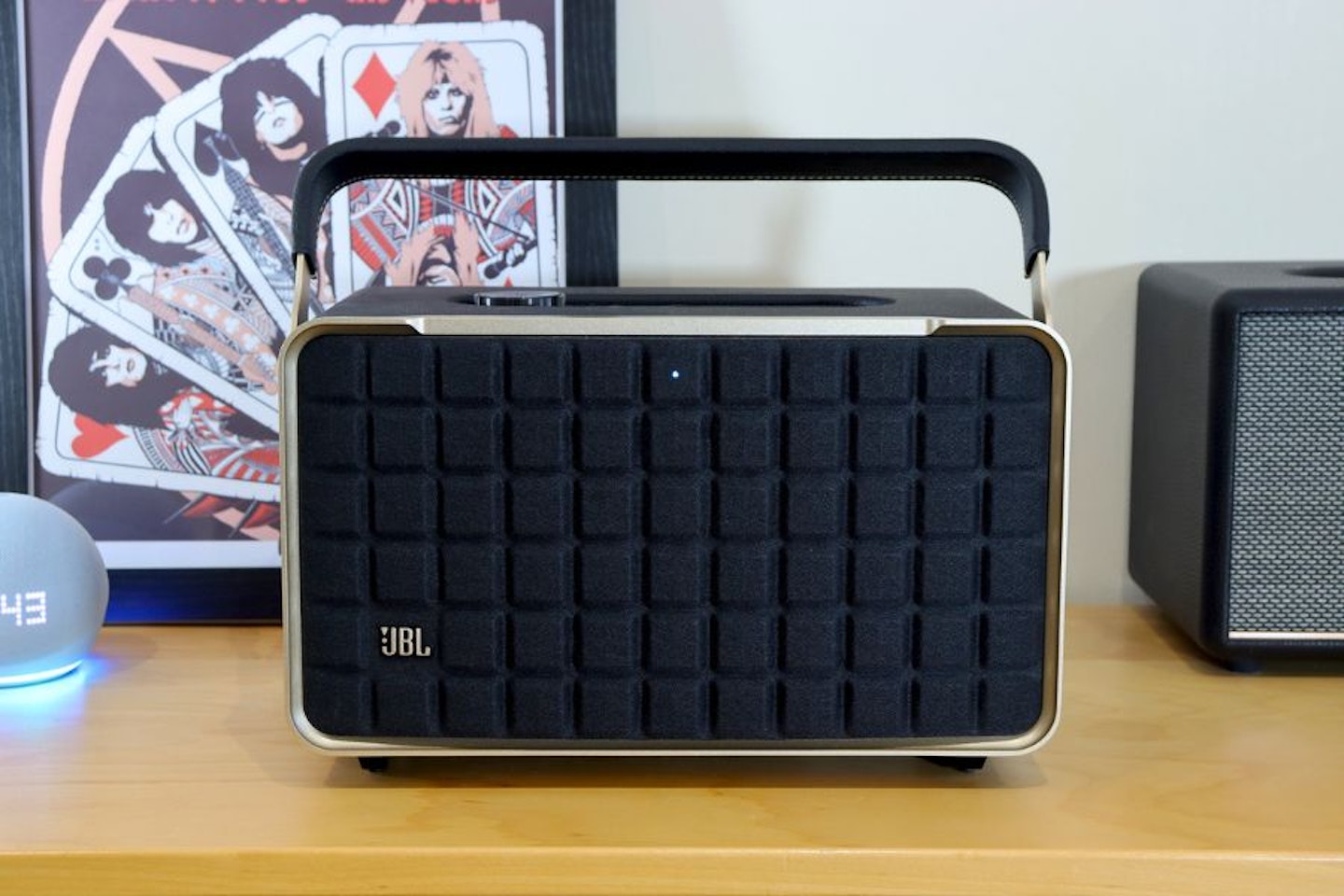
JBL Authentics 300: First impressions
I’ll be honest, when I first saw a picture of the JBL Authentics 300 I had trouble estimating its size. The top-mounted controls, chunky foam grill and conspicuous handle reminded me of those small-ish Bluetooth speakers or DAB radios you might take on a picnic. It's considerably larger, though, and I was immediately drawn to its metal trim and retro design cues. In terms of size and portability, the Authentics 300 is a modern take on the unwieldy boomboxes of the 80s. If its looks, weight and build quality were anything to go by, this was probably going to give my beloved Marshall Stanmore III that I reviewed a run for its money.
Before I even opened the box I knew that this speaker was, at the very least, built to last. And that’s simply down to the weight. Lifting it from the inner packaging, all 4.9kg of the JBL Authentics 300 instantly made this a two-handed operation.
I set it down on its substantial rubber feet and immediately realised that the metallic light-gold trim was indeed metal and not plated plastic, as was the seriously robust handle. The top panel is nicely inset with sizable high-quality rotary dials for tone and volume plus a handful of tactile buttons. And that imposing chunky front grill is surprisingly solid to the touch. Face to face, this really is the Yorkie Bar of speaker grills and a real departure from more commonplace speaker designs. I plugged in, powered on and was greeted with a satisfyingly bassy on-chime.
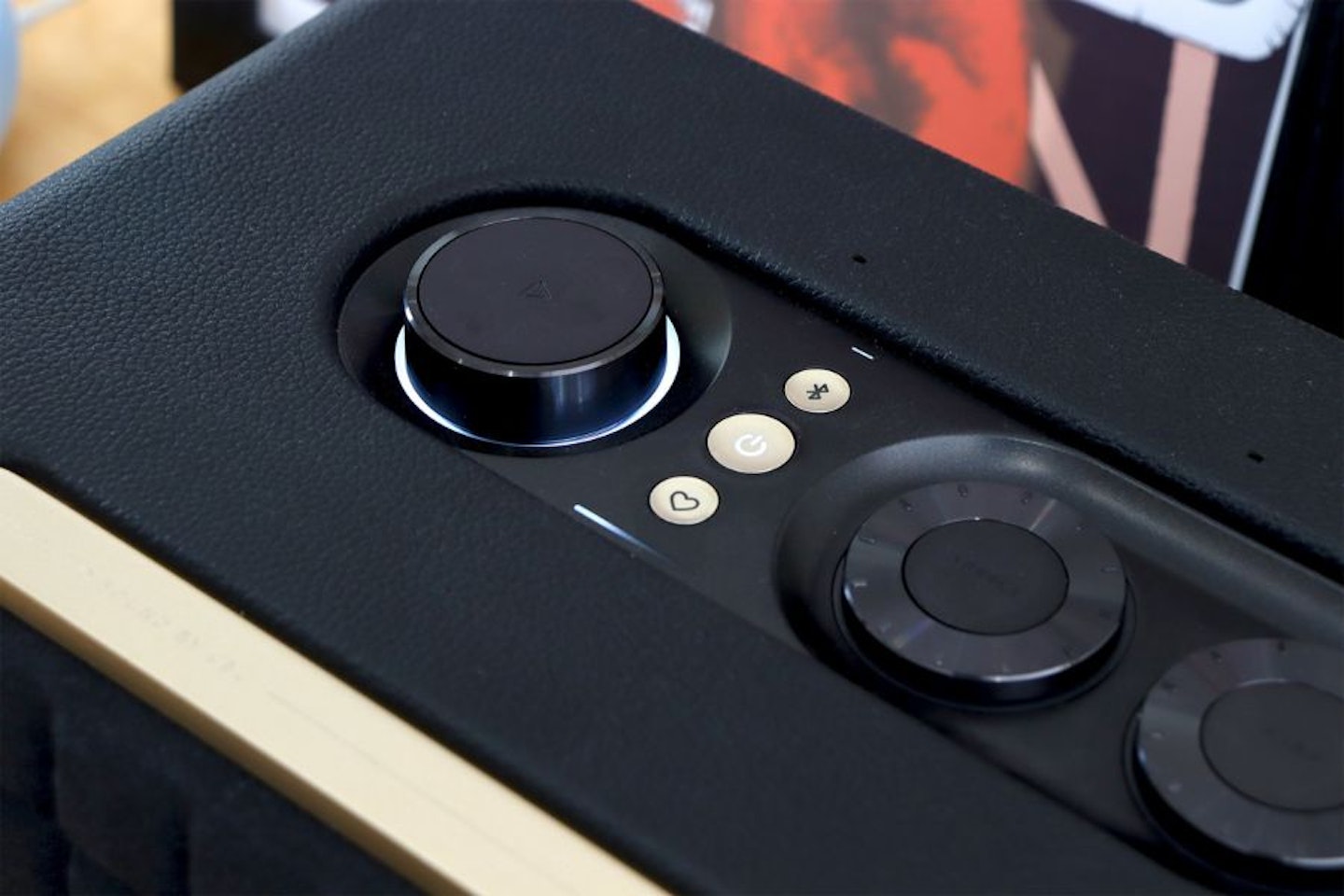
JBL Authentics 300: Performance
Speaker tech
When I read the spec of the Authentics 300, I couldn’t wait to put it through its paces at all volumes. Squirrelled away behind that blocky grill is a pair of 1-inch tweeters and a sizable 5.25-inch woofer. It boasts a frequency range of 45Hz - 20kHz too – that’s on par with many mid to high-budget passive speakers.
But there’s an ace up JBL’s sleeve: That huge down-firing 6.5-inch passive radiator. Despite being passive, it’s a force to be reckoned with. All that air movement inside the casing is piped downwards to create a serious amount of sub-bass even at moderate volumes. It’s not uncontrolled either, except at maximum volume when it can start to overpower and lose some definition. No wonder there are some heavy-duty rubber vibration-dampening feet underneath. On paper, there’s a lot of promise here.
Streaming music
First up was the easy option: playback over Bluetooth. As you’d expect from a compressed streaming format, the output is only as good as the source file (and the streaming technology) will allow. That said, hitting the play button on Amazon Music on my iPhone resulted in some seriously ground-thumping lows and well-defined highs and vocals – all helped by the superior bandwidth of the Bluetooth 5.3 standard.
The Authentics 300 belted out AC/DC with monstrous levels of bass, but only after I’d tweaked the bass to the max and the mids higher than standard via the JBL One app. That done, Brian Johnson’s vocals on ‘For Those About To Rock (We Salute You)’ were well defined from the bass and Angus Young’s axe. Only at the highest volume did the sound start to muddly slightly – and given the wall of sound that characterises rock and metal, I was impressed.
Likewise, used as an Airplay 2 speaker via my iPhone, playback from a variety of sources such as YouTube, and locally stored music at higher bitrates, was an instant and seamless experience.
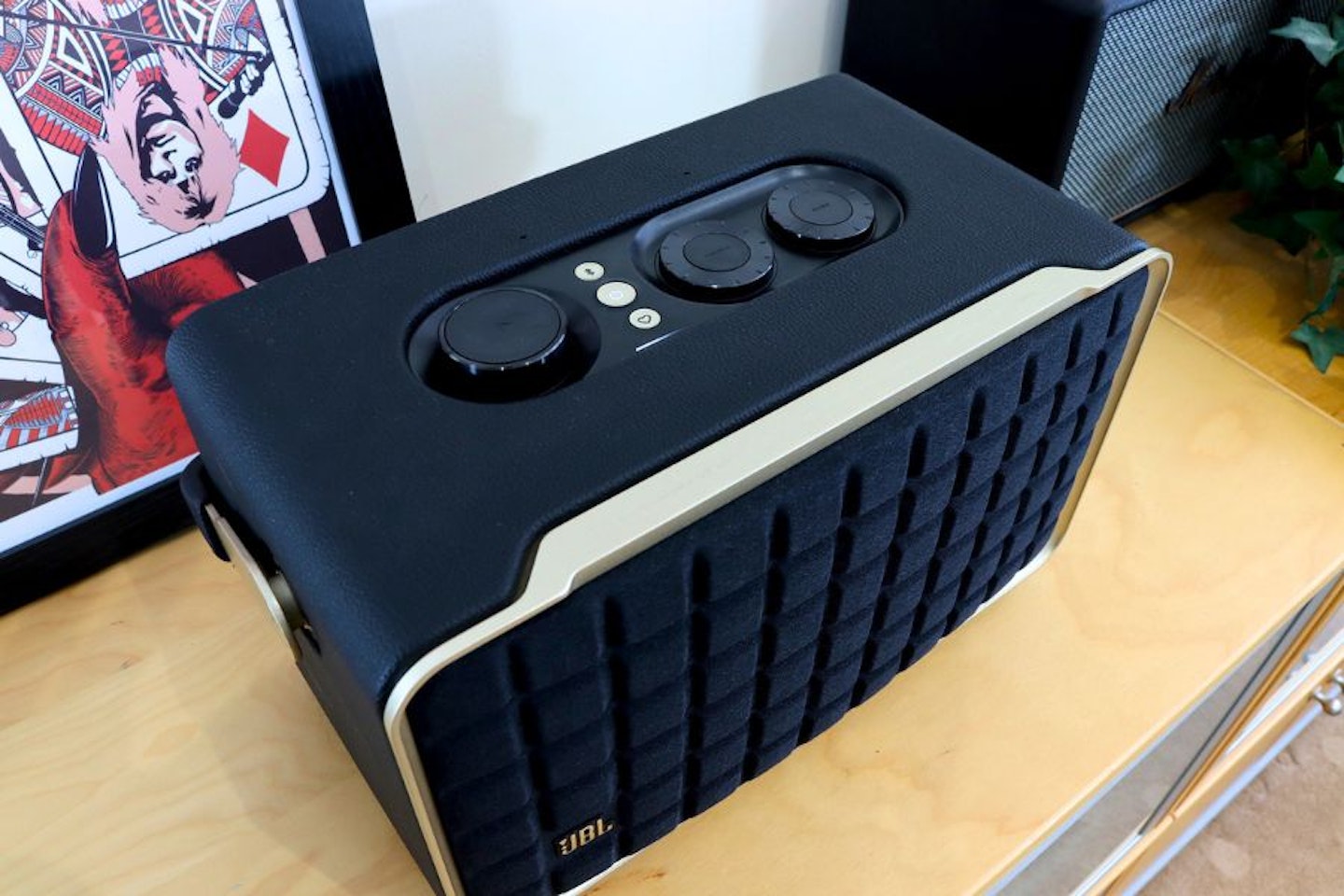
Spotify Connect and Alexa music
Bluetooth and Airplay aside, Wi-Fi playback was pretty much the same in terms of sound quality, but with the added benefit that wireless internet provides; Namely, not having your music playback tethered to any particular device. A case in point is Spotify Connect, and of course, streaming music via my home network and Alexa.
My home Alexa setup has routines that allow me to use simple voice commands to play playlists from services like Spotify and Amazon Music. Even better, I can tell it to play the music on specific groups of speakers for multi-room sound.
Asking for my movie soundtrack playlist I was treated to the delicate orchestral highs and thunderous lows of John William’s Raiders Of The Lost Ark. ‘The Raiders March’ was a particular highlight for its range on the Authentics 300, as was the relentless fusion of electronic and orchestral elements in ‘The Rig’ from Junkie XL’s Mad Max: Fury Road score. In general, the midrange was better defined on the more orchestral tracks, with the occasional bit of EQ tweaking via the app needed elsewhere for the best experience.
Internet radio and podcasts
One of the biggest surprises for me, having tested a wide range of wireless speakers, was the performance with low-bitrate internet radio stations. I put a lot of this down to the passive radiator and overall soundstage. Both really add a lot of warmth and depth to sources that might be lacking them, even smoothing over some of the digital cracks for the most compressed stations. Blues stations were smooth and nuanced, particularly at medium volumes, and 80s music had plenty of detail and punch to it.
Likewise, podcasts were surprisingly rich to listen to, with the Authentics 300 adding weight and presence to voices without overcooking them. It turns out that vocals are a real strength of this speaker’s overall sound profile. I’m used to hearing spoken word on portable speakers that sound tinny at lower volumes – not the case here.
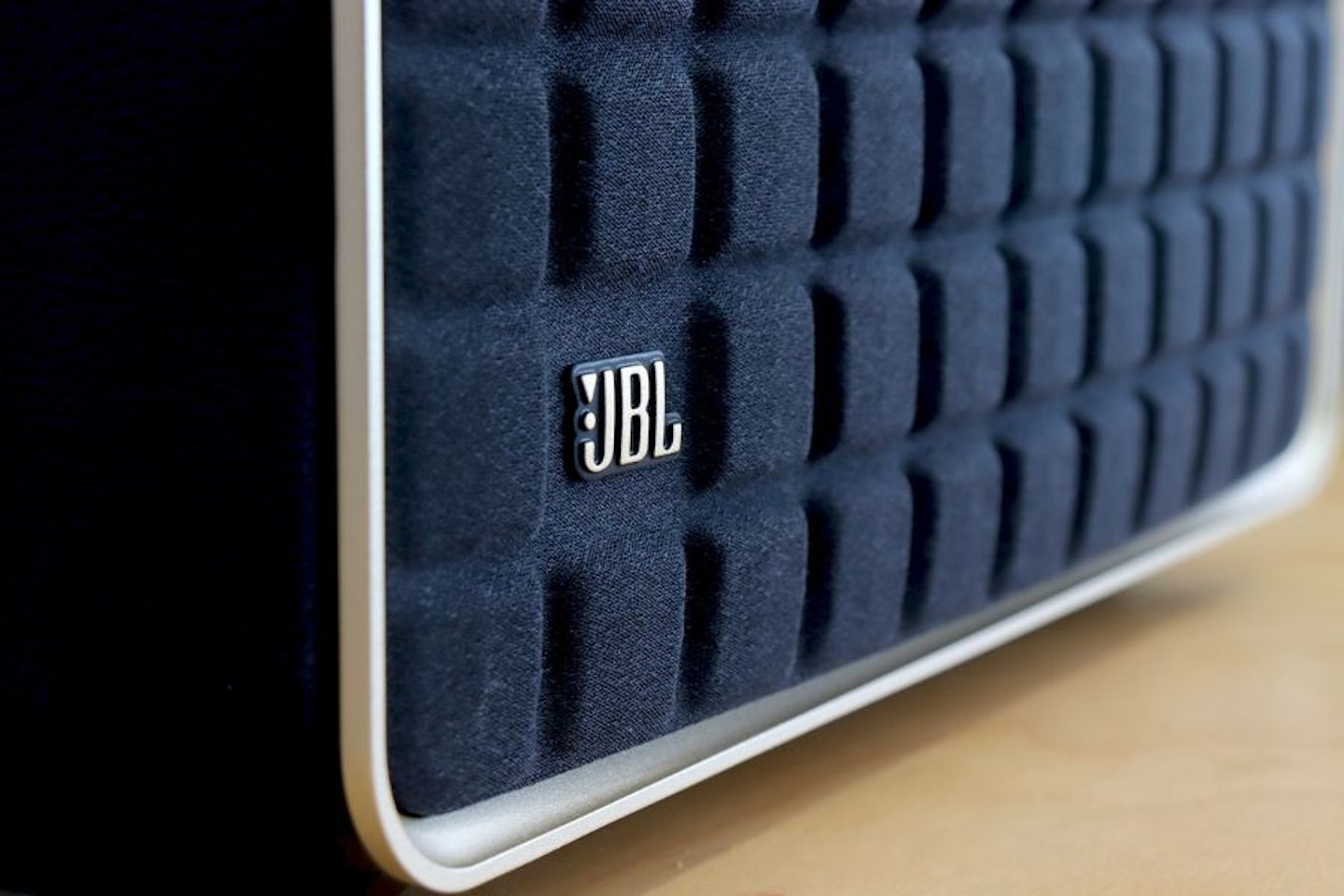
TV speaker test
There’s no doubt that the Authentics 300 isn’t really designed as a serious way to augment your TV’s sound. Unlike the Sonos Era 300 speaker, there’s no Dolby Atmos here for a start. But, I still wanted to try this out, so I paired it with my Panasonic QLED 50-inch TV. I also piped YouTube audio through from my iPad via Airplay. Thankfully, there were no major audio lag or sync issues with either. In the absence of a proper soundbar like the Majority Sierra Plus I reviewed, the Authentics 300 is really a step up from standard TV speakers. YouTube on the iPad did, of course, result in a serious power boost.
Auxillary input test
My old iPod Nano was pulled out of retirement for this simple test. A cable with a 3.5mm jack at either end is all that was needed. As the bitrate of the files on the Nano was better than most bog standard streaming services, the sound was nuanced and showed no signs of harshness at higher volumes.
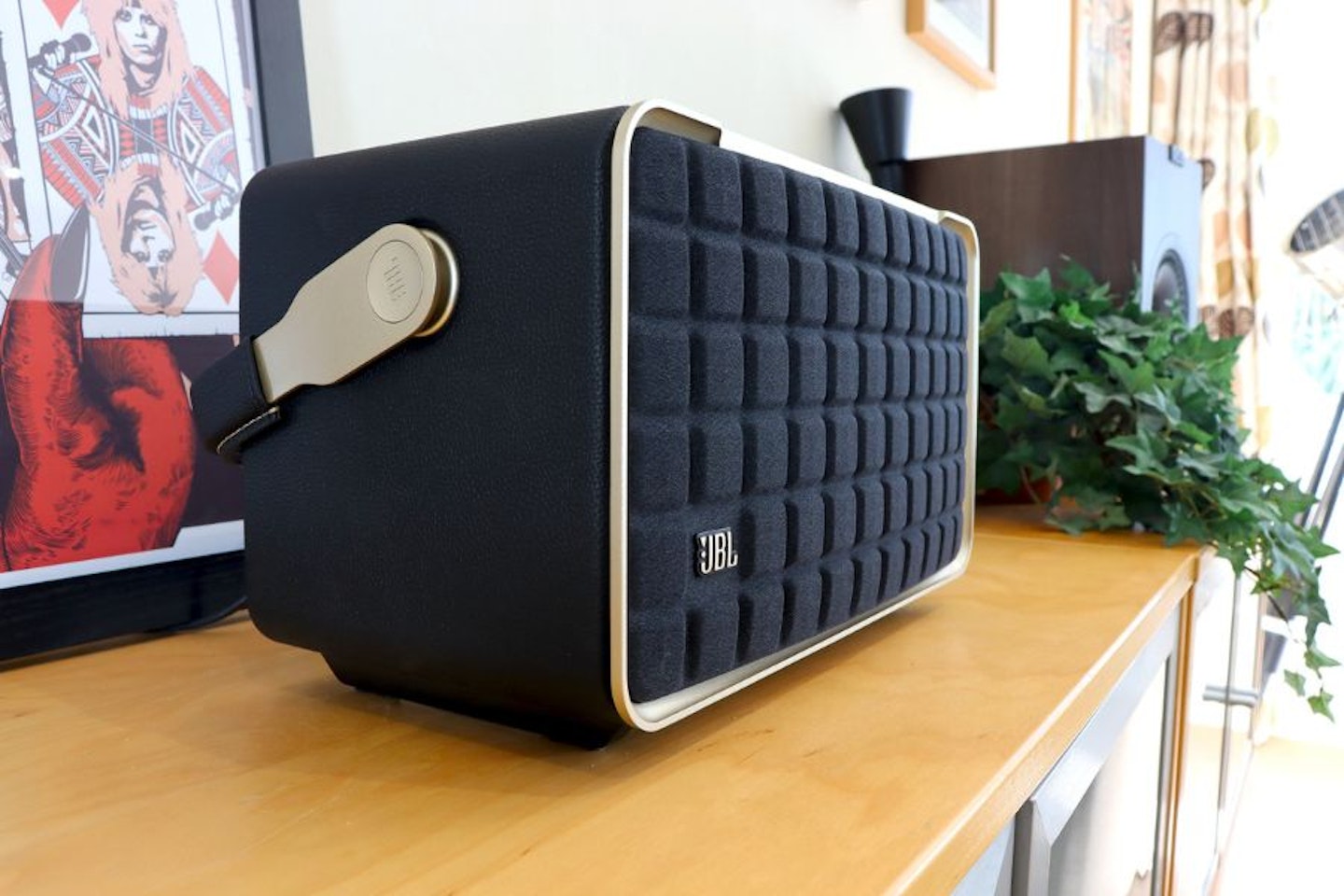
Overall sound
This speaker is well-defined at the top and mid-range, but for my taste, I had to turn the bass to maximum and tweak the treble down to reach something that sounded more balanced without drowning out the mids. I often used the app for finer control over those levels and elevating the mids – something that’s not possible with the physical controls. Even then, sometimes vocals and the high-end would compete with the bass, leading to more tweaking with the tone controls.
However, for me, the Authentics 300 still has a pleasing default sound profile. If anything it challenged my expectations having come from the Marshall Stanmore and its balanced yet bass-rich sound. As for the performance at maximum volumes, that’s when things start to threaten to break down. That’s true of the Marshall too, so it’s not surprising that when reaching 90-100 per cent volume the bass becomes ill-defined, the treble overpowered and the mids lost in between. But, to be fair many speakers wouldn't handle as much power as this one does with half as much grace.
At no time was the music unlistenable at those maximum volumes and, if anything, the further away I got from it the more listenable it became. In that regard, it would make a great party speaker, as the sound really does travel very well throughout a whole house. It might not have the nuanced profile of my Marshall, but it certainly belts out a tune with lots of range and musicality.
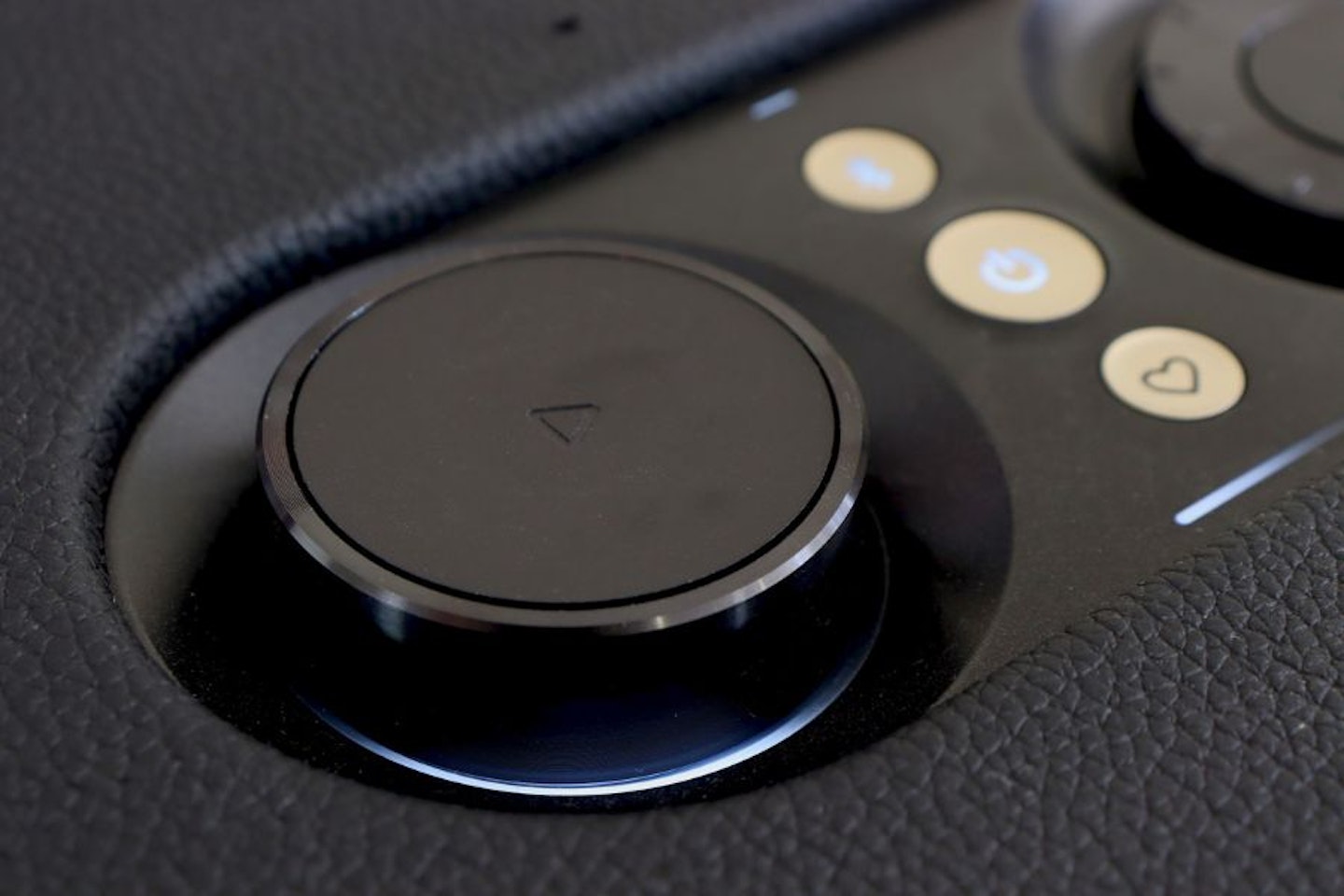
JBL Authentics 300: Connectivity
For me, one of the very few downsides of my go-to active speaker – the Marshall Stanmore III – is the lack of Wi-Fi connectivity. It’s also not a smart speaker in any way. So, the JBL Authentics 300 scores extra points here right off the bat. It’s packing dual band Wi-Fi as well, so that’s ideal for most home routers and networks. I found the connection to be rock-solid no matter where I placed the Authentics 300. If you have unreliable Wi-Fi you can even plug an ethernet cable into the rear panel.
Bluetooth is present of course, and it’s the primary way of getting the speaker onto your wireless network via the JBL One companion app (more on that below). Plus, I was happy to see that it’s Bluetooth 5.3, too. It’s better than previous versions thanks to its more stable connection and upper bitrate of 2Mbps; So you can expect your lossless music to sound excellent.
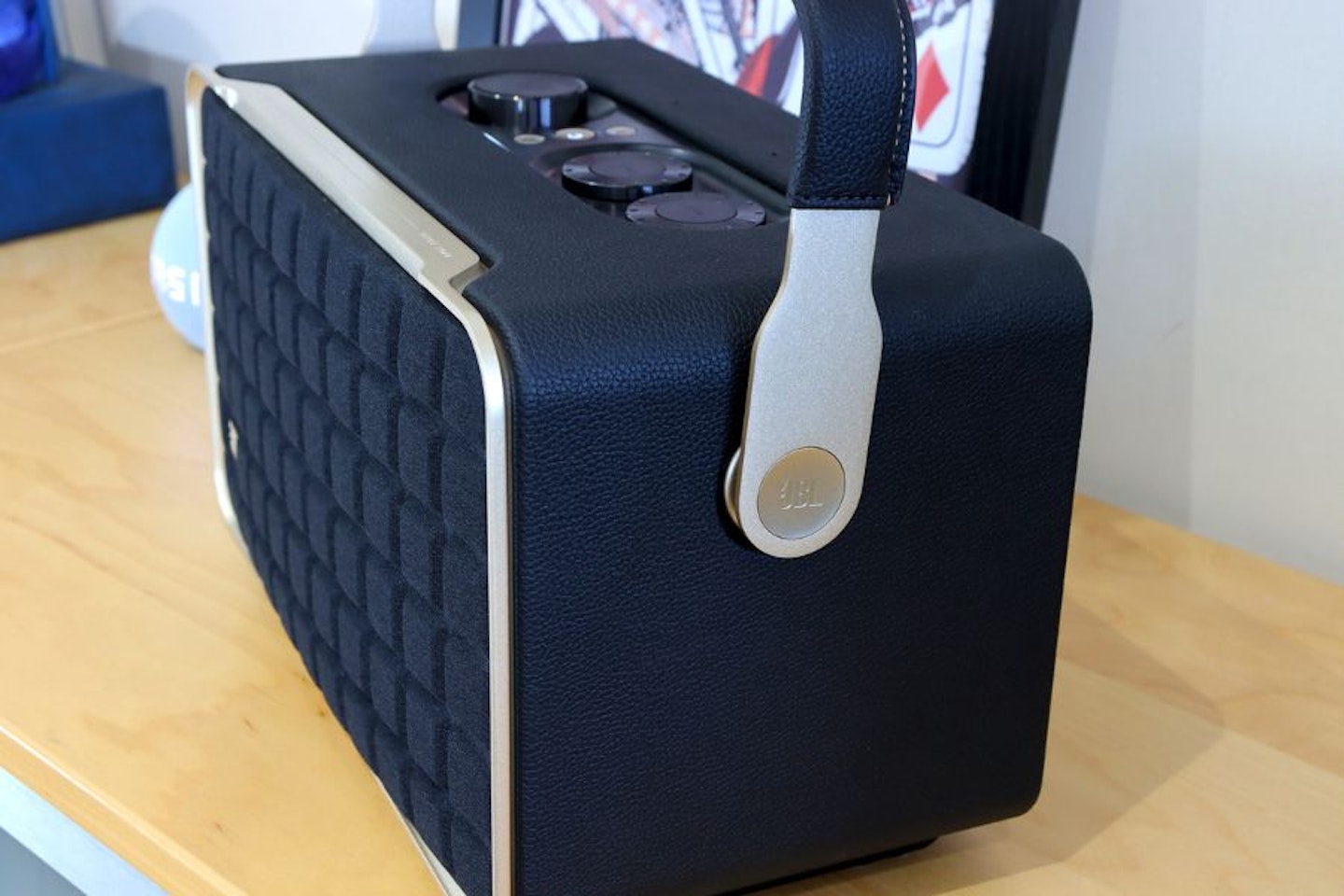
Ports
As for physical connections, this speaker has limited options. That said, as a primarily wireless speaker, that’s fine by me. It does have a USB-C type port, but take note: Playback of audio files from attached hard drives isn’t possible on the UK version, which is something of a strange restriction that doesn’t exist with the United States version.
For the rest of us here in Blighty that just leaves the trusty 3.5mm aux input. It may seem old-fashioned at this point, but anyone with an old MP3 player or phone with a headphone jack is going to love it. It means you can hook up older devices for playback when there’s no internet or for those who need to have their mobile paired with, say, a headset for work calls. It’s also a great analogue option for listening to those locally stored tracks that have been ripped into lossless formats, avoiding the compression that comes with most streaming services.
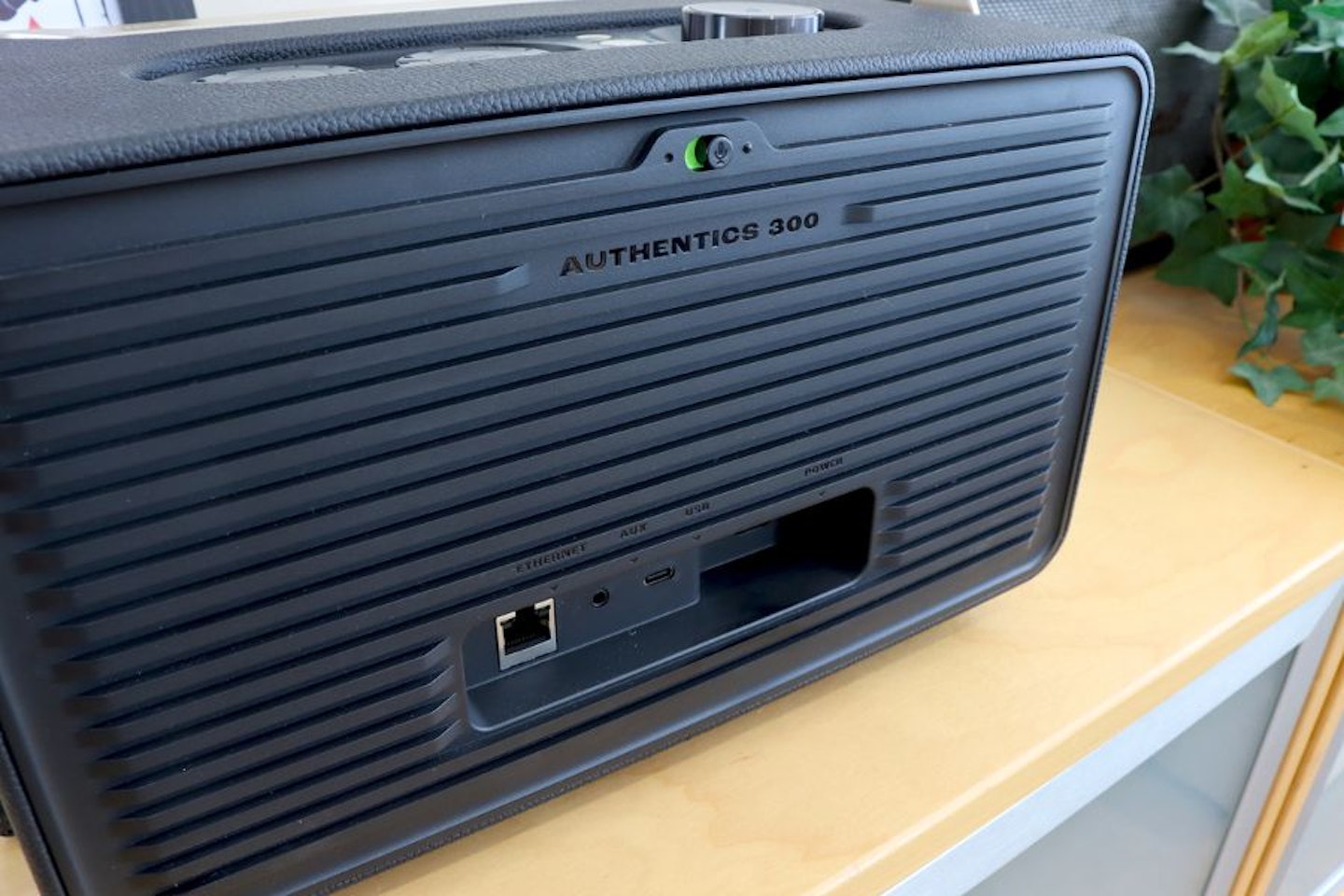
Smart speaker functionality
The JBL One app and supported streaming services
The JBL One app provides an impressive list of optional service integrations, from Amazon Music to TIDAL, TuneIn radio and more; And that’s on top of the standard AirPlay, Alexa Multi-Room Music (MRM), Spotify Connect, and Chromecast built-in capabilities for even more app compatibility. Opening the Spotify app on my iPhone instantly gave me the option of playback through the Authentics 300, and the same was true of Airplay.
I quickly came to appreciate the app’s Equaliser function, with its fast and intuitive graph-based controls to rebalance the sound profile. As I mentioned above, the unit itself only has bass and treble controls, so the ability to affect the mid frequencies in the app quickly became essential.
Connections and EQ aside, I find it handy to be able to use the app to set the time until the speaker auto-powers off, as is a power optimisation setting to maximise playback time.
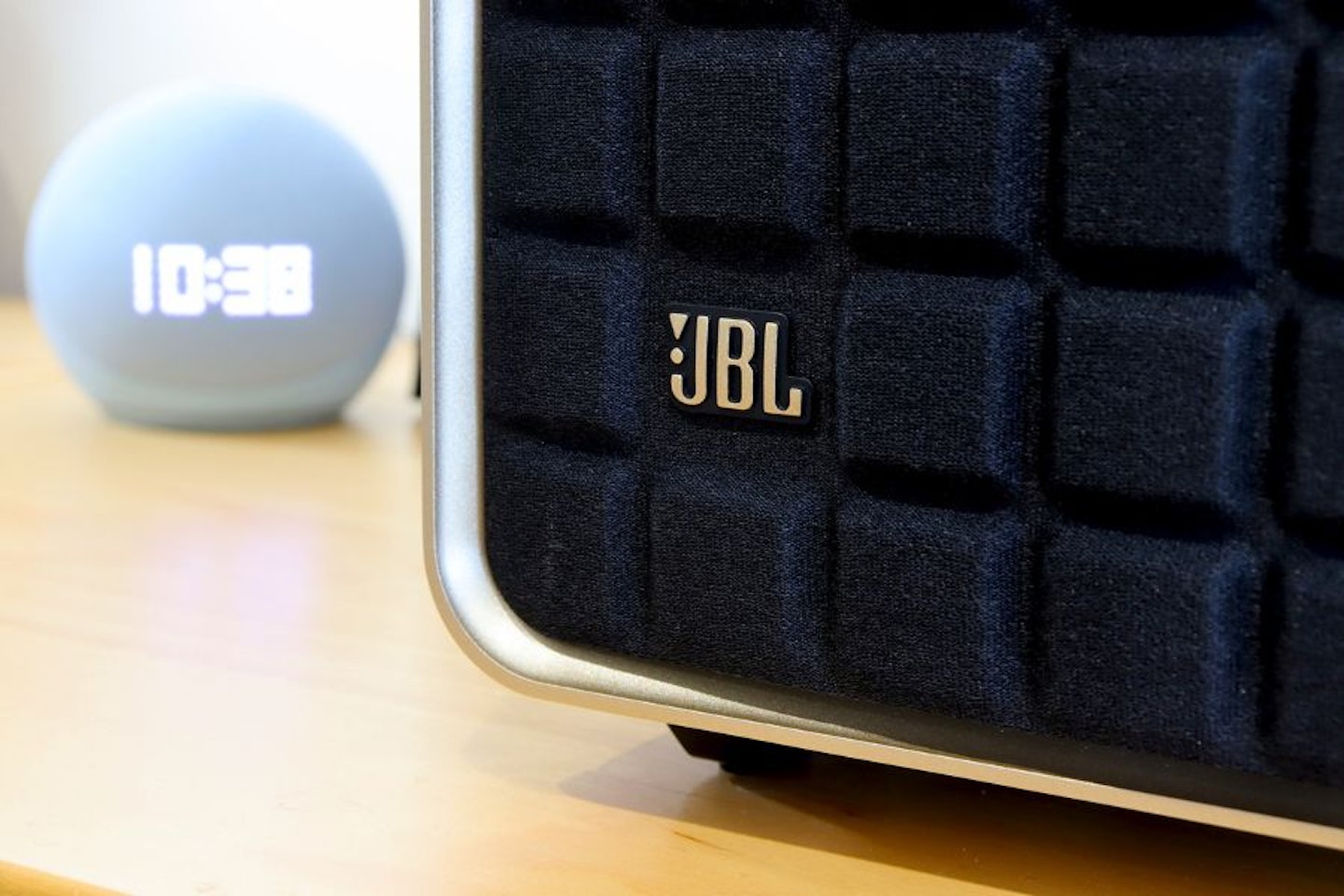
Adding the Authentics 300 to my existing Alexa setup
Another user-friendly part of setting the Authentics 300 up via the app were the prompts to select Alexa as my voice assistant. It also asked me to select which streaming music services I wanted to connect to. As my smart home is 100 per cent Alexa, I chose that. However, I could have chosen to use both Alexa and Google Assistant. All of the usual Alexa functionality is present, with control over smart home gadgets, web searches and more. I put the JBL's Alexa to the test by triggering my routine that sets my Ring security system to Away Mode and turns on various lights.
As an aside, I was happy to see that JBL included a discreet physical microphone switch on the back. It’s ideal for those concerned with privacy and equally handy where you have more than one Alexa speaker and want to ensure a response from a different device.

Multi-room music
Unlike the Sonos One I reviewed, here multi-room connectivity doesn’t force you to use a proprietary ecosystem. It’s one of the long-term headaches I’ve had with my Sonos One. It can’t be grouped with my Echo devices and can only respond to the wake word ‘Alexa’; so, it often ends up playing different music than the Echo Show in the same room.
Here, multi-room has to be configured as part of the Alexa (or Google Home) setup. With the Authentics 300 already part of my Alexa system, I used the Alexa app to add it to my ‘Everywhere’ speaker group. From there, I could instantly play the same music across a range of devices, from my Echo Show to Echo Dots and the Authentics 300, for a home-wide audio experience.
And I absolutely love this functionality. Personally, I’m not a fan of walled gardens when it comes to multi-room playback. My Sonos can only perform this feat with other Sonos devices. I prefer to be able to grow my smart speaker network organically and be free to add the Authentics 300 to any of the Alexa speaker groups I’ve already set up.
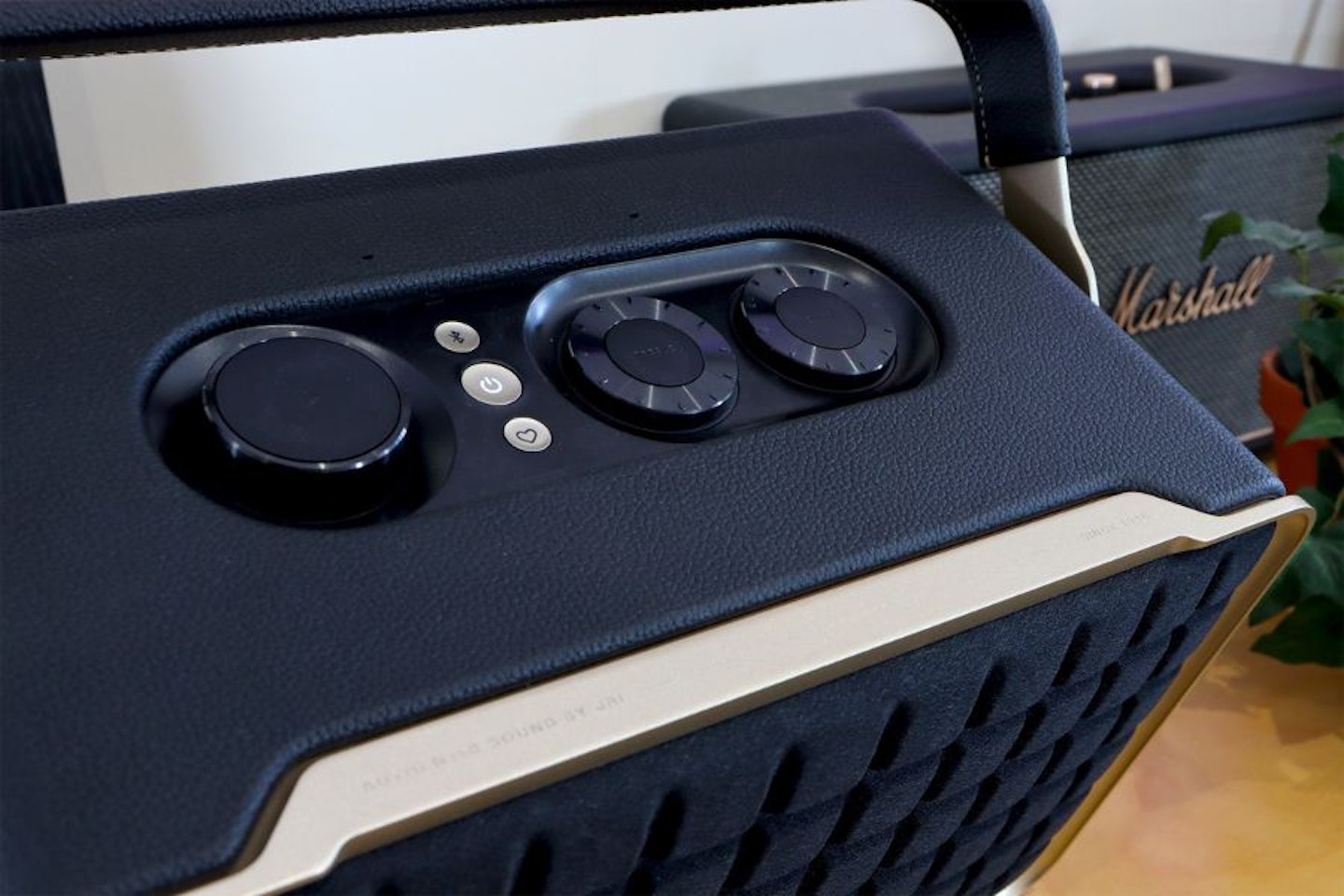
JBL Authentics 300: Controls
I’m a real fan of a few controls that do an awful lot. Here, the JBL Authentics 300 doesn’t disappoint. Proving that less is more when it comes to uncluttered design, the inset controls on the top are basically comprised of three rotary controls and four buttons.
The primary control is the larger volume knob that has a button mounted in the centre. The other two rotary controls are for treble and bass. They all have some weighting to them, especially the volume control; But for me, the bass and treble are quite light to the touch and take something away from the quality build seen everywhere else.
However, I am a fan of the ring of LEDs that light up to show the volume, bass and treble levels. Whereas the volume control LEDs have plenty of virtual notches in them, my nitpick is with the lights on the bass and treble knobs. They only have ten segments to them, so despite being unstepped rotary controls, they really only give you a range of 1-10 to choose from. As someone who tends to tweak things from album to album, I wish they could be more granular. But, at least the JBL One app gives a finer level of control across the board.
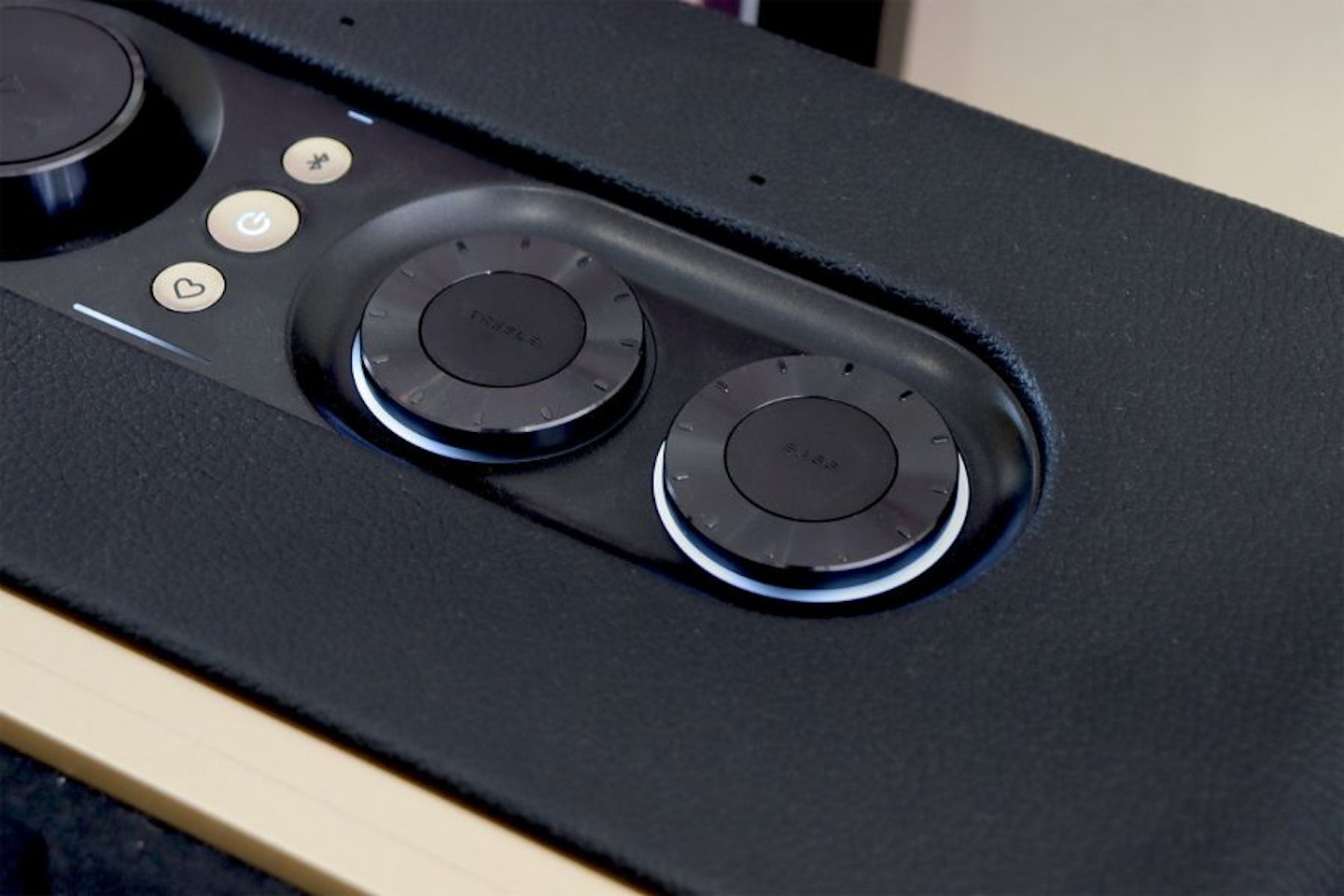
Buttons
The button built into the volume control is multifunction with a set of commands that I really appreciate for their simplicity. One click to play or pause, two to skip forward, three to skip back. The other three buttons are simple and tactile with a slightly concave profile and inset light-up symbols. You get Power, Bluetooth Pairing and Moments – the latter being a heart icon that’s essentially a shortcut to your favourite album or playlist. The JBL One app lets you choose from any of your supported streaming music services and assign a playlist to the heart button – which JBL oddly call the ‘Moments Button.
So I connected to Amazon Music and my Classic Rock playlist. One hit of the heart button and bam – Mötley Crüe all day long. But, I do find it frustrating that I can’t create a ‘Moment’ using a playlist from my Spotify account. Although this speaker has full Spotify Connect functionality, it’s not on the list of supported music services in the Moment section of the app.
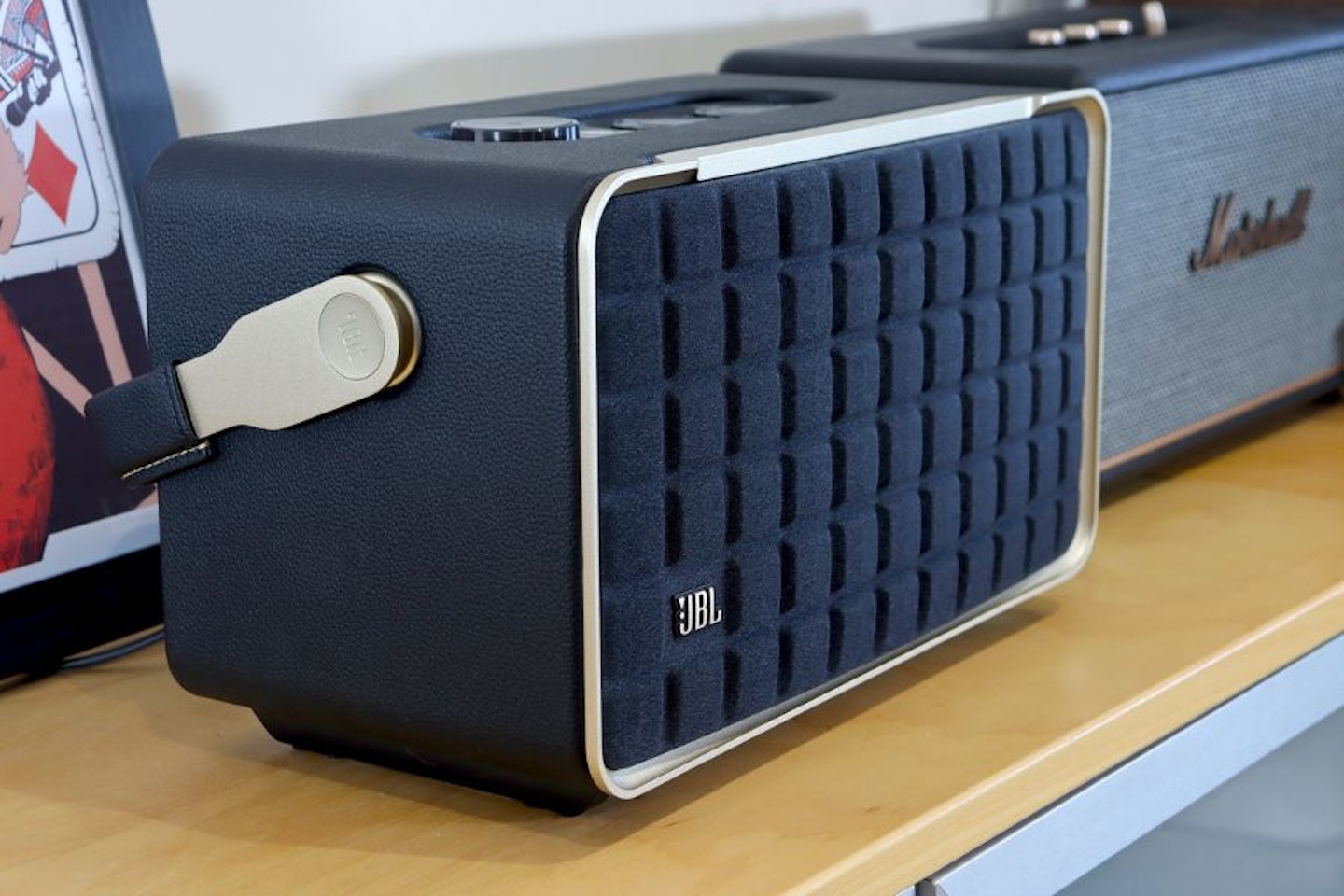
Design and build
I really appreciate the vintage speaker-inspired design of the Authentics 300. Although arguably its most notable feature, that blocky Quadrex-style grill is a direct callback to the L100 series speaker that would become an iconic piece of ‘70s hi-fi kit thanks to its roots as a pro studio monitor. The top surface of the light-gold front trim is subtly etched with ‘Authentic sound by JBL since 1946’ – which may well be a surprise for some in terms of lineage and the JBL speaker brand.
That said, unlike lesser brands who simply tick the retro box by cramming generic innards into a plastic recreation of a radio from the ‘50s or ‘60s, JBL has made the Authentics 300 a thing in its own right. It has a refreshingly simple control layout and the whole device has a pleasingly uncluttered uniformity – largely thanks to that bold front grill. And I do have a thing for LEDs concealed behind speaker grills. This one has a single blue light behind the fabric at the top to show when Alexa is listening – a wise design choice for a retro speaker like this. For me, the design is equal parts authentic nostalgia and unashamed modernity.
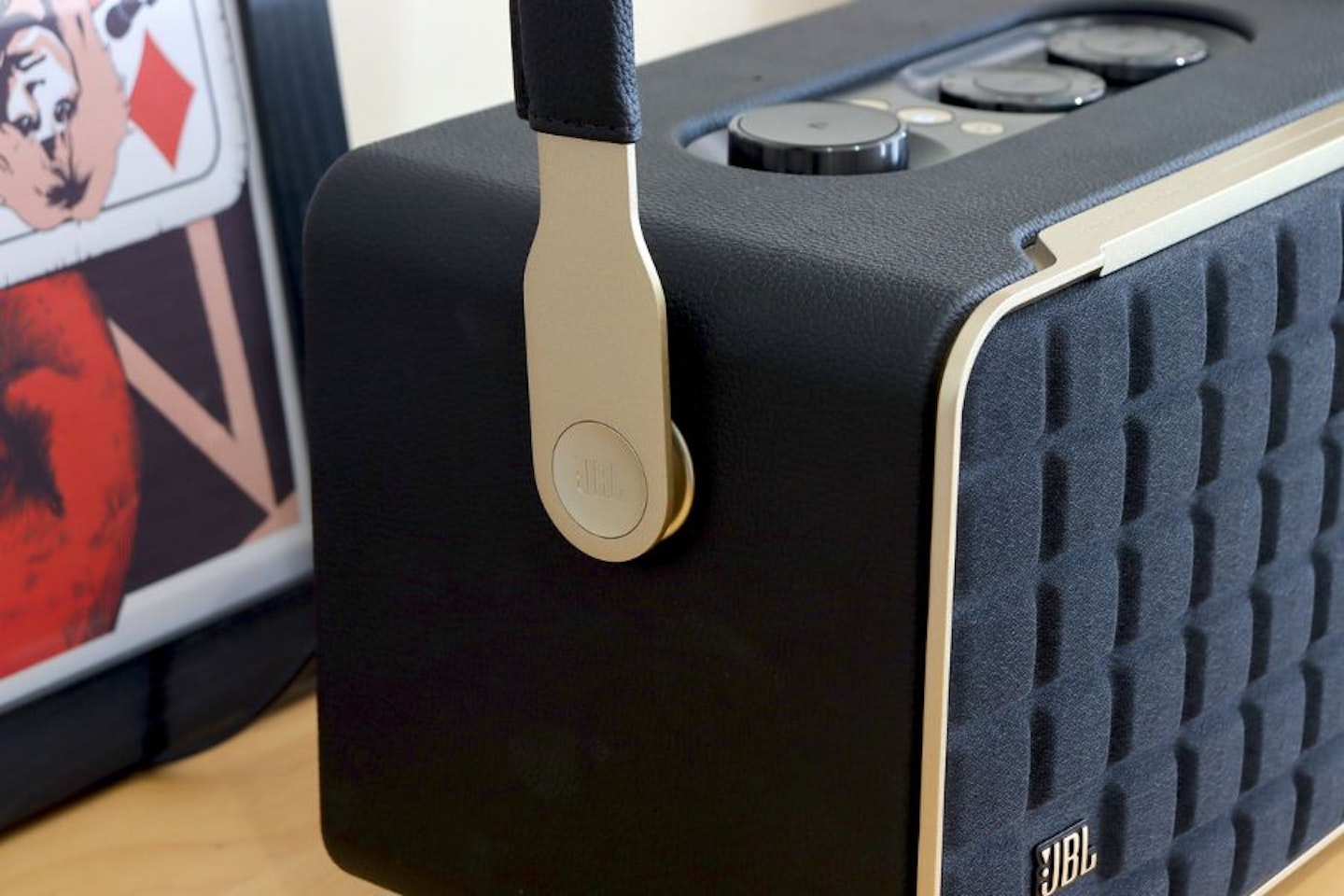
Built to last
Style aside, I think it’s the build that makes this speaker really special compared to its peers. It’s constructed with a considerable amount of craft and precision. It’s one thing to use premium materials like metal and textured heavy-duty plastics, but it’s another to build a device without the odd unsightly seam or slightly rough fit and finish here and there. This speaker screams high-end premium build from every angle.
The large rubber feet do a great job of dampening vibrations – essential, as the Authentics 300’s downward-firing radiator is ridiculously powerful. It’ll massively vibrate any surface, so if you want to re-create that moment in Jurassic Park when the T-rex’s footsteps send ripples through a cup of water, you’re likely to end up with a major spillage instead.
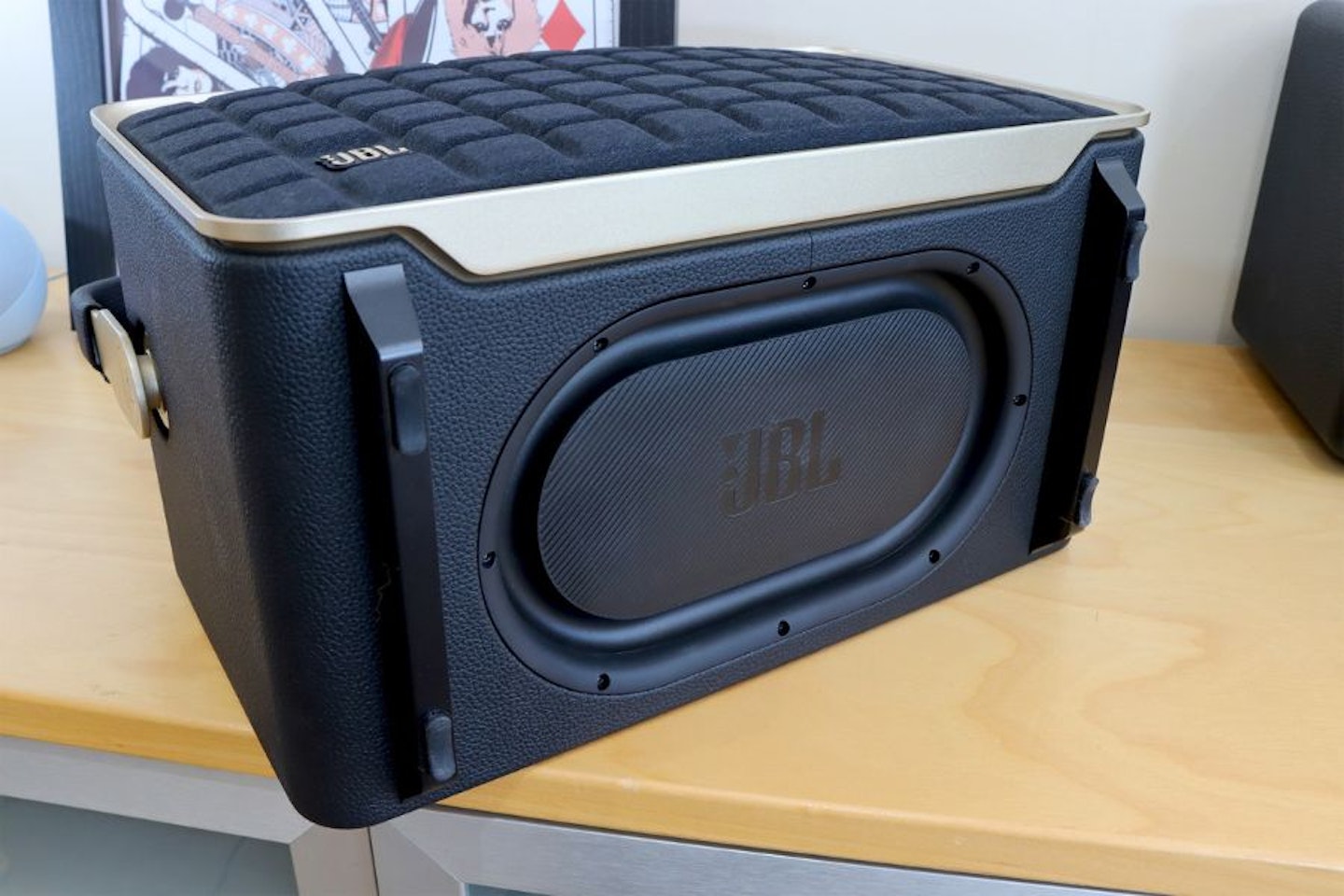
How portable is it?
However, I do think that the choice between mains power and around eight hours of battery-powered playback is a slightly odd proposition for a speaker without weather resistance or an IPX rating. Yes, it’s great to be able to unhook this from the socket and lug it to another room, but I’d hesitate to take this out and about in uncertain weather. That said, the battery life was indeed around the eight-hour mark on a full charge – impressive for a speaker with this much oomph.
The design and colour scheme certainly don’t yell ‘throw me into your campervan’ or ‘take me to a garden party and leave me near the pool’ either. There’s no sense that this is impact-resistant or heavy-duty in the slightest – I’d certainly hate to see that light-gold trim get scuffed. That said, if you’re a little bit protective over where you place it, the flexibility to move the Authentics 300 around a bit is a welcome perk.
Price and competition
Portable active speakers of this size and spec, not to mention Alexa and Google Assistant functionality, are something of a rarity. For me, the JBL Authentics 300’s competition is split into two categories: Portable, and Wired. Purely based on price and smarts, the most obvious contender is the Sonos Era 300. It’s an Alexa and Airplay 2 device with the added benefit of Dolby Atmos for spatial audio. It is a little smaller, but it has no battery, so it’s not quite as flexible as the JBL.
In the Portable category is the rock-solid Bang And Olufsen Beolit 20 speaker. It’s more expensive, only has Bluetooth and has no voice assistant functionality. But, if you’re all about portable sound of the highest calibre, this is it. Like the Authentics, it has around eight hours of playback on a full charge. But there’s a bit more portability here thanks to the smaller size and weight, plus the welcome addition of wireless smartphone charging.
redirect.viglink.com
Despite names that share the same numbering, the Sonos Era 300 and JBL Authentics 300 similarities end there. The Sonos is in no way portable or rechargeable, despite the smaller, lighter design. But, what it loses in portability it gains in spatial audio capabilities. It’s equipped with a six-speaker Dolby Atmos setup. It also has voice assistant functionality for your smart speaker functions like home automation.
Pros
- Superior sound quality thanks to the inclusion of Dolby Atmos
- Seamless integration with Sonos ecosystem
- 360-degree spatial audio
Cons
- Not portable or rechargeable
| Drivers | Four tweeters, two woofers |
| Audio power | 170W |
| Connectivity | Wi-Fi, Bluetooth, USB-C |
| Battery life | N/A |
| Charging time | N/A |
| Waterproofing | None |
| Dimensions | 16 x 26 x 18cm (HxWxD) |
| Weight | 4.5kg |
If you like the portability of the JBL Authentics 300 but don’t need a smart speaker, this Bang And Olufsen Beolit 20 is a great choice that will appeal to audiophiles. Aside from the brand’s reputation for stellar sound, this speaker has a massive 37-hour battery life and benefits from a convenient wireless phone charger on the top. Smaller, and at almost half the weight of the Authentics, it’s also a lot more portable.
Pros
- Impressive sound quality and bass response
- Long battery life for extended play
- Sleek and stylish design
Cons
- No voice control or smart speaker functionality
| Drivers | 3.5-inch woofer, three 1.5-inch full-range drivers |
| Audio power | 2 x 35 W Class D for woofer and tweeter |
| Connectivity | Bluetooth 4.2, 3.5mm stereo jack, USB-C |
| Battery life | Up to 37 hours |
| Charging time | 3 hours |
| Waterproofing | IPX4 |
| Dimensions | 18.9 x 13.5 x 23 (HxWxD) |
| Weight | 2.7kg |

Final thoughts
Who is it for?
For me, the JBL Authentics 300 is for listeners who want all of the convenience of a modern smart speaker with the kind of sound quality you’d expect from decent mid-budget hi-fi speakers. The sound is solid and satisfyingly well-rounded, with only a few harsh edges to be heard at maximum volume. Despite its battery and reassuringly solid handle, it’s not for those who like to take their tunes with them into the great outdoors due to its weight, size and lack of weather protection. It is, however, perfect for someone who wants the flexibility to move a quality speaker from room to room without having to unplug and interrupt their playback. But, it’s also about that big sound and decent musicality – qualities not normally seen in the average luggable wireless speaker.
Would we recommend it
By the end of my testing, it’s fair to say that I had fallen in love with the JBL Authentics 300. My Marshall Stanmore III did stare accusingly at me from time to time, and I did miss its rock and metal-friendly sound profile and well-defined bass response. But, the sheer reach and power of the Authentics 300 wooed me in the end, even though I find its soundstage to be a little less defined and more top-heavy than the Marshall. For my taste, the Marshall is still a better performer for musicality and frequency range, but the JBL Authentics 300 does manage to deliver a satisfying and powerful experience while also nailing the vintage speaker design aesthetic that I really appreciate.
I think of it as a house party speaker for its well-rounded sound and powerful reach, but also as a quality smart speaker for casual listening over Wi-fi; both of those are tricks that the Marshall and others can’t pull off. As smart speakers with a lot of connectivity options go, the JBL Authentics 300 comes highly recommended. Initially won over by its retro looks and quality build, it’s also turned out to be the powerful Wi-Fi and Alexa-enabled speaker I always wanted.
Pros
- Well-rounded sound profile with lots of bass
- Alexa and Google Assistant voice control integration
- Authentic retro-inspired design
Cons
- Limited portability due to weight, size and lack of weatherproofing
| Drivers | 1x 5.25-inch woofer, 2x 1-inch tweeters (plus passive radiator) |
| Audio power | 100W |
| Connectivity | Wi-Fi, Bluetooth, Aux-in, USB (for servicing only on UK models) |
| Battery life | 8 hours |
| Charging time | 3 hours |
| Waterproofing | None |
| Dimensions | 22.7 x 38.4 x 22cm (HxWxD) |
| Weight | 4.8kg |
Who tested it?
Chris Duffill is one of our senior commercial content writers specialising in audiovisual and computing. He's also been a video producer, using professional audio and camera gear for a variety of shoots and in post-production. At home, he’s also into entertainment tech – from home cinema and surround sound to hi-fi; including turntables, speakers, amps and multiroom systems.
How was it tested?
I used the JBL Authentics 300 every day for around three weeks. It was used on both mains and battery power and placed in a number of rooms and settings, including outside in fair weather. It was used to stream music over Wi-Fi from Spotify Premium and Apple Music via Airplay; and also internet radio apps via a Bluetooth-connected iPhone. A wide range of musical genres were tested, as were spoken voice and TV audio. Alexa was tested by adding the Authentics 300 to my home Wi-Fi network via the companion app. I then added it to my existing smart speaker setup using the Alexa app. The speaker’s companion app was also tested for its remote control functionality.
Chris Duffill is a Senior Tech Product Writer for What's The Best. His background includes writing, editorial, marketing, design, video production and photography.
He specialises in home entertainment and audiovisual tech, including speakers, amplifiers, turntables, streaming media players, and TVs. He is also one of our resident experts in computing (PCs, tablets, smartphones, smartwatches), DSLR photography and all kinds of digital cameras. He also writes about retro gaming, game consoles and various electronic gadgets. If it plugs in, lights up or makes a noise, he’ll write about it.
Subscribe to the What's The Best Newsletter to keep up to date with more of the latest reviews and recommendations from the rest of the What’s The Best team.










